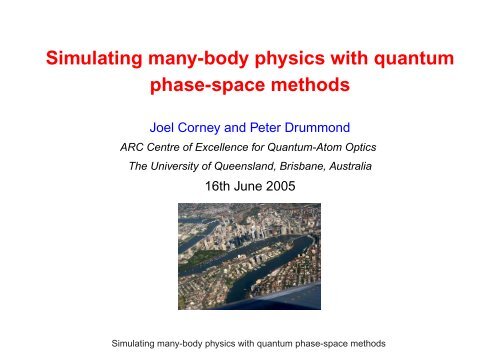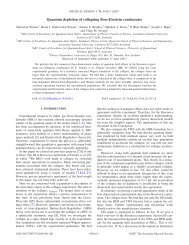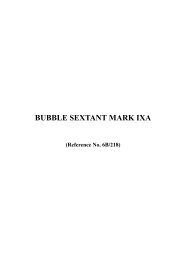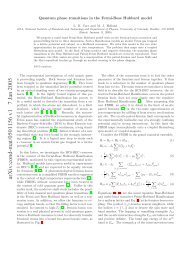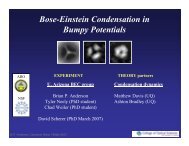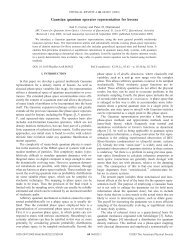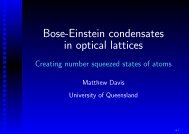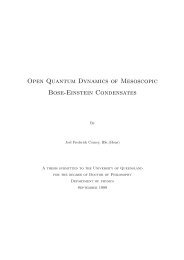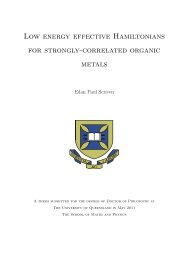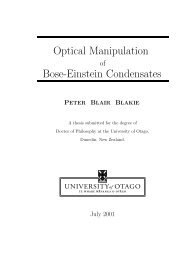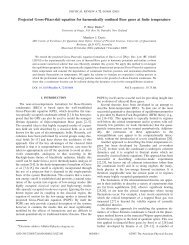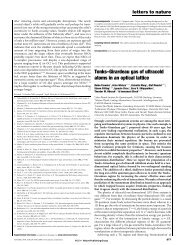Simulating many-body physics with quantum phase-space methods
Simulating many-body physics with quantum phase-space methods
Simulating many-body physics with quantum phase-space methods
- No tags were found...
You also want an ePaper? Increase the reach of your titles
YUMPU automatically turns print PDFs into web optimized ePapers that Google loves.
<strong>Simulating</strong> <strong>many</strong>-<strong>body</strong> <strong>physics</strong> <strong>with</strong> <strong>quantum</strong><strong>phase</strong>-<strong>space</strong> <strong>methods</strong>Joel Corney and Peter DrummondARC Centre of Excellence for Quantum-Atom OpticsThe University of Queensland, Brisbane, Australia16th June 2005<strong>Simulating</strong> <strong>many</strong>-<strong>body</strong> <strong>physics</strong> <strong>with</strong> <strong>quantum</strong> <strong>phase</strong>-<strong>space</strong> <strong>methods</strong>
Simplicity of Photons and Ultracold Gases✔ underlying interactions are well understood✔ easily characterised by a few parameters✔ interactions can be tuned→ use simple theoretical models to high accuracy→ develop and test new <strong>methods</strong> of calculation<strong>Simulating</strong> <strong>many</strong>-<strong>body</strong> <strong>physics</strong> <strong>with</strong> <strong>quantum</strong> <strong>phase</strong>-<strong>space</strong> <strong>methods</strong> 2
Theoretical Methods✄ deterministic <strong>methods</strong>:➜ exact diagonalisation ✖ intractable for 5 particles➜ factorization ✖ not applicable for strong correlations➜ perturbation theory ✖ diverges at strong couplings✄ probabilistic <strong>methods</strong>:➜ <strong>quantum</strong> Monte Carlo (QMC)➜ stochastic wavefunction/fields➜ <strong>phase</strong>-<strong>space</strong> <strong>methods</strong><strong>Simulating</strong> <strong>many</strong>-<strong>body</strong> <strong>physics</strong> <strong>with</strong> <strong>quantum</strong> <strong>phase</strong>-<strong>space</strong> <strong>methods</strong> 3
Overview✄ introduction to <strong>phase</strong>-<strong>space</strong> representations✄ density operator description of <strong>quantum</strong> evolution (3 classes)➜ static, unitary and open✄ Gaussian operator bases (3 types)➜ coherent, thermal and squeezed✄ applications (3 examples)➜ pulse propagation in optical fibres (photons)➜ Hubbard model (atoms)➜ simple atomic-molecular dynamics (molecules)<strong>Simulating</strong> <strong>many</strong>-<strong>body</strong> <strong>physics</strong> <strong>with</strong> <strong>quantum</strong> <strong>phase</strong>-<strong>space</strong> <strong>methods</strong> 4
Overview✄introduction to <strong>phase</strong>-<strong>space</strong> representations✄ density operator description of <strong>quantum</strong> evolution (3 classes)➜ static, unitary and open✄ Gaussian operator bases (3 types)➜ coherent, thermal and squeezed✄ applications (3 examples)➜ pulse propagation in optical fibres (photons)➜ Hubbard model (atoms)➜ simple atomic-molecular dynamics (molecules)<strong>Simulating</strong> <strong>many</strong>-<strong>body</strong> <strong>physics</strong> <strong>with</strong> <strong>quantum</strong> <strong>phase</strong>-<strong>space</strong> <strong>methods</strong> 5
Phase-<strong>space</strong> distributions✄ A classical state can be represented by a joint probability distribution in<strong>phase</strong> <strong>space</strong> P(x,p)✄ 1932: Wigner constructed an analogous quantity for a <strong>quantum</strong> state:ZW(x, p) = 2 πdyψ ∗ (x − y)ψ(x + y)exp(−2iyp/)✔ Wigner function gives correct marginals:RdxW(x, p) = 2P(p)RdyW(x, p) = 2P(x)✘ but it is not always positive → not a true joint probability✄ a positive Wigner function is a hidden variable theory<strong>Simulating</strong> <strong>many</strong>-<strong>body</strong> <strong>physics</strong> <strong>with</strong> <strong>quantum</strong> <strong>phase</strong>-<strong>space</strong> <strong>methods</strong> 6
Probability distributions✄ <strong>many</strong> ways to define <strong>phase</strong>-<strong>space</strong> distributions:➜ eg Wigner, Husimi Q and Glauber-Sudarshan P☛ all defined in terms of coherent states☛ correspond to different choices of orderings✄ to be a probabilistic representation, the <strong>phase</strong>-<strong>space</strong> functions must:P W Qexist and be nonsingular ✖ ✔ ✔always be positive ✖ ✖ ✔evolve via drift and diffusion ✖ ✖ ✖<strong>Simulating</strong> <strong>many</strong>-<strong>body</strong> <strong>physics</strong> <strong>with</strong> <strong>quantum</strong> <strong>phase</strong>-<strong>space</strong> <strong>methods</strong> 7
Phase-<strong>space</strong> representation̂ρ =ZP( −→ λ )̂Λ( −→ λ )d −→ λ✄ P( −→ λ )is a probability distribution✄ ̂Λ( −→ λ ) is a suitable operator basis✄ −→ λ is a generalised <strong>phase</strong>-<strong>space</strong> coordinate✄ d −→ λ is an integration measure✄ equivalent tôρ = E[̂Λ(−→ λ )]<strong>Simulating</strong> <strong>many</strong>-<strong>body</strong> <strong>physics</strong> <strong>with</strong> <strong>quantum</strong> <strong>phase</strong>-<strong>space</strong> <strong>methods</strong> 9
<strong>Simulating</strong> <strong>many</strong>-<strong>body</strong> <strong>physics</strong> <strong>with</strong> <strong>quantum</strong> <strong>phase</strong>-<strong>space</strong> <strong>methods</strong> 10
Overview✄ introduction to <strong>phase</strong>-<strong>space</strong> representations✄density operator description of <strong>quantum</strong> evolution (3 classes)➜ static, unitary and open✄ Gaussian operator bases (3 types)➜ coherent, thermal and squeezed✄ applications (3 examples)➜ pulse propagation in optical fibres (photons)➜ Hubbard model (atoms)➜ simple atomic-molecular dynamics (molecules)<strong>Simulating</strong> <strong>many</strong>-<strong>body</strong> <strong>physics</strong> <strong>with</strong> <strong>quantum</strong> <strong>phase</strong>-<strong>space</strong> <strong>methods</strong> 11
Density operators for <strong>quantum</strong> evolutioniĤt/1. Unitary dynamics: ̂ρ(t) = e−iĤt/̂ρ(0)e ]✄ ∂t̂ρ ∂ = − i [Ĥ,̂ρ2. Equilibrium state: ̂ρ un (T ) = e − (Ĥ−µ̂N)/k B T]✄ ∂β̂ρ ∂ = 1 2[Ĥ − µ̂N,̂ρ ; β = 1/k BT+3. Open dynamics: ̂ρ Sys = Tr Res {̂ρ}] ()✄ ∂t̂ρ ∂ = − i [Ĥ,̂ρ + γ 2 ̂R̂ρ ̂R † − ̂R † ̂R̂ρ − ̂ρ ̂R † ̂R✄ each type is equivalent to a Liouville equation for ̂ρ:ddτ̂ρ = ̂L[̂ρ] ; τ = t,β<strong>Simulating</strong> <strong>many</strong>-<strong>body</strong> <strong>physics</strong> <strong>with</strong> <strong>quantum</strong> <strong>phase</strong>-<strong>space</strong> <strong>methods</strong> 12
1. Formulate: ∂̂ρ/∂τ = ̂L[̂ρ]Phase-<strong>space</strong> Recipe2. Expand: R ∂P/∂τ ̂Λd −→ λ = R ]P̂L[̂Λ]3. Transform: ̂L[̂Λ= L ̂Λd −→ λ4. Integrate by parts: R PL ̂Λd −→ λ =⇒ R ̂ΛL ′ Pd −→ λ5. Obtain Fokker-Planck equation: ∂P/∂τ = L ′ P6. Sample <strong>with</strong> stochastic equations for −→ λ<strong>Simulating</strong> <strong>many</strong>-<strong>body</strong> <strong>physics</strong> <strong>with</strong> <strong>quantum</strong> <strong>phase</strong>-<strong>space</strong> <strong>methods</strong> 13
Stochastic Gauges✄ Mapping from Hilbert <strong>space</strong> to <strong>phase</strong> <strong>space</strong> not unique➜ <strong>many</strong> “gauge” choices✄ Can alter noise terms B i j , introduce arbitrary drift functions g j ( −→ λ )Weight dΩ/dτ = Ω[U + g j ζ j ]Trajectory dλ i /∂τ = A i + B i j [ζ j − g j ]✄ Can also choose different bases, identities<strong>Simulating</strong> <strong>many</strong>-<strong>body</strong> <strong>physics</strong> <strong>with</strong> <strong>quantum</strong> <strong>phase</strong>-<strong>space</strong> <strong>methods</strong> 14
Interacting <strong>many</strong>-<strong>body</strong> <strong>physics</strong>̂ρ =⇒ −→ λ✔ <strong>many</strong>-<strong>body</strong> problems map to nonlinear stochastic equations✔ calculations can be from first principles✔ precision limited only by sampling error✔ choose basis to suit the problem<strong>Simulating</strong> <strong>many</strong>-<strong>body</strong> <strong>physics</strong> <strong>with</strong> <strong>quantum</strong> <strong>phase</strong>-<strong>space</strong> <strong>methods</strong> 15
Overview✄ introduction to <strong>phase</strong>-<strong>space</strong> representations✄ density operator description of <strong>quantum</strong> evolution (3 classes)➜ static, unitary and open✄Gaussian operator bases (3 types)➜ coherent, thermal and squeezed✄ applications (3 examples)➜ pulse propagation in optical fibres (photons)➜ Hubbard model (atoms)➜ simple atomic-molecular dynamics (molecules)<strong>Simulating</strong> <strong>many</strong>-<strong>body</strong> <strong>physics</strong> <strong>with</strong> <strong>quantum</strong> <strong>phase</strong>-<strong>space</strong> <strong>methods</strong> 16
Operator Bases✄ need basis simple enough to fit into a computer, complex enough to containthe relevant <strong>physics</strong>:ρPΛσ ρ=∼σ P⊗+σ Λ<strong>Simulating</strong> <strong>many</strong>-<strong>body</strong> <strong>physics</strong> <strong>with</strong> <strong>quantum</strong> <strong>phase</strong>-<strong>space</strong> <strong>methods</strong> 17
General Gaussian operatorsa generalisation of the density operators that describe Gaussian states✄ Gaussian states can be:➜ coherent (for bosons), squeezed, or thermal➜ or any combination of these✄ characterised by first-order moments: x, p, x 2 , p 2 , xp➜ all higher-order moments factorise<strong>Simulating</strong> <strong>many</strong>-<strong>body</strong> <strong>physics</strong> <strong>with</strong> <strong>quantum</strong> <strong>phase</strong>-<strong>space</strong> <strong>methods</strong> 18
Gaussian Basis I: Coherent-state projectorŝΛ =∣ α〉〈(α + ) ∗∣ ∣〈(α+ ) ∗∣ ∣ ∣ ∣α 〉✄ defines the +P distribution, <strong>with</strong> a doubled <strong>phase</strong> <strong>space</strong> −→ λ = (Ω,α,α + )✄ 〈 moments: O ( â † ,â )〉 = E [O(α + ,α)]✄ successful for <strong>many</strong> applications in <strong>quantum</strong> optics✄ successful simulations of short-time <strong>quantum</strong> dynamics of BEC<strong>Simulating</strong> <strong>many</strong>-<strong>body</strong> <strong>physics</strong> <strong>with</strong> <strong>quantum</strong> <strong>phase</strong>-<strong>space</strong> <strong>methods</strong> 19
Gaussian Basis II: Thermal operatorŝΛ = |I ± n| ∓1 : exp[â(I ∓ I − [I ± n] −1) ]â †:✄ now have a <strong>phase</strong> <strong>space</strong> of variances: −→ λ = (Ω,n)✄ defined for bosons (upper sign) and fermions (lower sign)✄ moments:〈 〉â † i â j= E [n i j ] ,〈â † i ↠jâ jâ i〉= E [n ii n j j ± n i j n ji ]✄ suitable for cold atoms<strong>Simulating</strong> <strong>many</strong>-<strong>body</strong> <strong>physics</strong> <strong>with</strong> <strong>quantum</strong> <strong>phase</strong>-<strong>space</strong> <strong>methods</strong> 21
Gaussian Basis III: General form (including squeezing)̂Λ( −→ ∣∣∣ λ ) = Ω√σ∣∓1: exp[δâ ( )† I ∓ I − σ −1]δâ/2:relative displacement: δâ = â − αannihilation and creation operators: â =()â 1 ,...,â M ,â † 1 ,...,↠Mcoherent offset: α = ( α 1 ,...,α M ,α + 1 ,...,α+ M), (α = 0 for fermions)covariance: σ =[ n T ± I mm + I ± n], I =[ ±I 00 I].upper signs: bosons; lower signs:fermions<strong>Simulating</strong> <strong>many</strong>-<strong>body</strong> <strong>physics</strong> <strong>with</strong> <strong>quantum</strong> <strong>phase</strong>-<strong>space</strong> <strong>methods</strong> 22
Extended <strong>phase</strong> <strong>space</strong>−→ λ = (Ω,α,α + ,n,m,m + )=⇒ Hilbert-<strong>space</strong> dimension: 2 M for fermions, N M for bosons=⇒ <strong>phase</strong>-<strong>space</strong> dimension: 2(1−M +2M 2 ) for fermions, 2(1+3M +2M 2 )for bosons✄ Moments:〈 〉〈â i 〉 = E [α i ]â † i â j = E [ α + i α ]j + n i j〈â i â j 〉 = E [α i α j + m i j ]<strong>Simulating</strong> <strong>many</strong>-<strong>body</strong> <strong>physics</strong> <strong>with</strong> <strong>quantum</strong> <strong>phase</strong>-<strong>space</strong> <strong>methods</strong> 23
Overview✄ introduction to <strong>phase</strong>-<strong>space</strong> representations✄ density operator description of <strong>quantum</strong> evolution (3 classes)➜ static, unitary and open✄ Gaussian operator bases (3 types)➜ coherent, thermal and squeezed✄applications (3 examples)➜ pulse propagation in optical fibres (photons)➜ Hubbard model (atoms)➜ simple atomic-molecular dynamics (molecules)<strong>Simulating</strong> <strong>many</strong>-<strong>body</strong> <strong>physics</strong> <strong>with</strong> <strong>quantum</strong> <strong>phase</strong>-<strong>space</strong> <strong>methods</strong> 24
Application I: photons in a fibreĤ = Ĥ F + Ĥ L + Ĥ G + Ĥ R✄ Ĥ F :fibre-optic Hamiltonian, including χ (3) nonlinearity✄ Ĥ L , Ĥ G : coupling to absorbing reserviors and fibre amplifier reserviors✄ Ĥ R : nonlinear coupling to non-Markovian phonon reserviors➜ models Raman transitions and Brillouin effect (GAWBS)✄ have 10 2 modes and 10 9 particles<strong>Simulating</strong> <strong>many</strong>-<strong>body</strong> <strong>physics</strong> <strong>with</strong> <strong>quantum</strong> <strong>phase</strong>-<strong>space</strong> <strong>methods</strong> 25
Scaled <strong>quantum</strong> field✄ define a <strong>quantum</strong> photon-density field in terms of mode operators:̂Ψ(t,x) = 1 √2πZdk â(t,k)e i(k−k 0)x+iω 0 t ;[̂Ψ(t,x), ̂Ψ† (t,x ′ )]= δ(x − x ′ )✄ change to propagative reference frame <strong>with</strong> scaled variables:t ⇔ (t − x/v)/t 0 x ⇔ x/x 0̂φ = ̂Ψ √ vt 0 /n➜ t 0 is a typical pulse duration➜ x 0 = t 2 0 /|k′′ | is the dispersion length➜ n = |k ′′ |Ac/(n 2 ω 2 ct 0 ) is a typical photon number<strong>Simulating</strong> <strong>many</strong>-<strong>body</strong> <strong>physics</strong> <strong>with</strong> <strong>quantum</strong> <strong>phase</strong>-<strong>space</strong> <strong>methods</strong> 26
Quantum Langevin Equations✄ Raman-modified Heisenberg equations for photon-flux field:Z∂∞= − dt∂x̂φ(t,x) ′ g(t −t ′ )̂φ(t ′ ,x) + ̂Γ(t,x) ± i ∂ 2−∞ 2∂t 2̂φ(t,x)[ Z ∞]+ i dt ′ h(t −t ′ )̂φ † (t ′ ,x)̂φ(t ′ ,x) + ̂Γ R (t,x) ̂φ(t,x)−∞✄ correlations of the reservoir fields:〈̂Γ(ω,x)̂Γ † (ω ′ ,x ′ )〉= αAn (ω,x)δ(x − x′ )δ(ω − ω ′ )〈̂Γ † (ω ′ ,x ′ )̂Γ(ω,x)〉= αGn (ω,x)δ(x − x′ )δ(ω − ω ′ )〈̂Γ R† (ω ′ ,x ′ )̂Γ R (ω,x)〉= αRn (|ω|)[n th(|ω|) + Θ(−ω)]δ(x − x ′ )δ(ω − ω ′ )<strong>Simulating</strong> <strong>many</strong>-<strong>body</strong> <strong>physics</strong> <strong>with</strong> <strong>quantum</strong> <strong>phase</strong>-<strong>space</strong> <strong>methods</strong> 27
Phase-Space Equations✄ apply the <strong>phase</strong>-<strong>space</strong> recipe, use coherent-state basis✄ two choices:1. +P(a) exact(b) defined on a doubled <strong>phase</strong> <strong>space</strong>(c) maps to normally ordered correlations2. Wigner(a) approximation, good for large mode occupations, short times(b) defined on a classical <strong>phase</strong> <strong>space</strong>(c) maps to symmetrically ordered correlations<strong>Simulating</strong> <strong>many</strong>-<strong>body</strong> <strong>physics</strong> <strong>with</strong> <strong>quantum</strong> <strong>phase</strong>-<strong>space</strong> <strong>methods</strong> 28
Wigner Equations✄ get stochastic, Raman-modified nonlinear Schrödinger equation:∂∂x φ(t,x) = − Z ∞✄ noise correlations:+dt ′ g(t −t ′ )φ(t ′ ,x) + Γ(t,x) ± i−∞ 2∂t 2φ(t,x)Z ∞]dt ′ h(t −t ′ )φ ∗ (t ′ ,x)φ(t ′ ,x) + Γ R (t,x) φ(t,x)[i−∞〈Γ(ω,x)Γ ∗ (ω ′ ,x ′ )〉 = αA (ω) + α G (ω)δ(x − x ′ )δ(ω − ω ′ )2n〈Γ R (ω,x)Γ R∗ (ω ′ ,x ′ ) 〉 =[n αRn (|ω|) th (|ω|) + 1 ]δ(x − x ′ )δ(ω − ω ′ )2〈∆φ(t,0)∆φ ∗ (t ′ ,0)〉 = 1 2n δ(t −t′ )∂ 2<strong>Simulating</strong> <strong>many</strong>-<strong>body</strong> <strong>physics</strong> <strong>with</strong> <strong>quantum</strong> <strong>phase</strong>-<strong>space</strong> <strong>methods</strong> 29
<strong>Simulating</strong> <strong>many</strong>-<strong>body</strong> <strong>physics</strong> <strong>with</strong> <strong>quantum</strong> <strong>phase</strong>-<strong>space</strong> <strong>methods</strong> 30
+P Equations✄ get two stochastic Raman-modified nonlinear Schrödinger equations:∂∂x φ(t,x) = − Z ∞+dt ′ g(t −t ′ )φ(t ′ ,x) + Γ(t,x) ± i−∞ 2∂t 2φZ ∞]dt ′ h(t −t ′ )φ + (t ′ ,x)φ(t ′ ,x) + Γ R (t,x) φ(t,x)[i−∞Z∂∞∂x φ+ (t,x) = − dt ′ g ∗ (t −t ′ )φ + (t ′ ,x) + Γ + (t,x) ∓ i ∂ 2−∞ 2∂t [2φZ ∞]+ −i dt ′ h ∗ (t −t ′ )φ(t ′ ,x)φ + (t ′ ,x) + Γ R+ (t,x)−∞✄ for non-classical states, φ and φ + are not complex conjugate∂ 2φ + (t,x)<strong>Simulating</strong> <strong>many</strong>-<strong>body</strong> <strong>physics</strong> <strong>with</strong> <strong>quantum</strong> <strong>phase</strong>-<strong>space</strong> <strong>methods</strong> 31
+P noise correlations〈Γ(ω,x)Γ ∗ (ω ′ ,x ′ )〉 = αG (ω)δ(x − x ′ )δ(ω − ω ′ )n〈Γ R (ω,x)Γ R+ (ω ′ ,x ′ ) 〉 = αRn (|ω|)[n th(|ω|) + Θ(−ω)]δ(x − x ′ )δ(ω − ω ′ )〈Γ R (ω,x)Γ R (ω ′ ,x ′ ) 〉 = 1 {α R (|ω|)[n th (|ω|) + Θ(−ω)] − iRe[h(ω)] }n×δ(x − x ′ )δ(ω + ω ′ )✄ no initial noise for a coherent state✄ but there is multiplicative noise due to spontaneous scattering<strong>Simulating</strong> <strong>many</strong>-<strong>body</strong> <strong>physics</strong> <strong>with</strong> <strong>quantum</strong> <strong>phase</strong>-<strong>space</strong> <strong>methods</strong> 32
Simulations✄ soliton jitter, soliton squeezing, supercontinuum generationfb3 ; 1000 paths0123abc42Relative noise (dB)0−2−4−6−8−10Electronic onlyRaman T=300KRaman T = 1E−6K0 2 4 6 8 10 12x/x 0<strong>Simulating</strong> <strong>many</strong>-<strong>body</strong> <strong>physics</strong> <strong>with</strong> <strong>quantum</strong> <strong>phase</strong>-<strong>space</strong> <strong>methods</strong> 33
Application II: atoms in a lattice|1>|2>|1>FermionsBosonsĤ = −∑ t i j ĉ † i,σĉ j,σ +U ∑ĉ †i j,σjj,↑ĉ† j,↓ĉ j,↓ĉ j,↑✄ simplest model of an interacting Fermi gas on a lattice➜ weak-coupling limit → BCS transitions➜ solid-state models; relevance to High-T c superconductors<strong>Simulating</strong> <strong>many</strong>-<strong>body</strong> <strong>physics</strong> <strong>with</strong> <strong>quantum</strong> <strong>phase</strong>-<strong>space</strong> <strong>methods</strong> 34
Solving the Hubbard Model✄ only the 1D model is exactly solvable (Lieb & Wu, 1968)✄ even then, not all correlations can be calculated✄ higher dimensions - can use Quantum Monte Carlo <strong>methods</strong>.✘ except for a few special symmetrical cases, QMC suffers from sign problems<strong>with</strong> the Hubbard model✄ e.g. sign problems for repulsive interaction away from half filling✘ sign problem increases <strong>with</strong> dimension, lattice size, interaction strength<strong>Simulating</strong> <strong>many</strong>-<strong>body</strong> <strong>physics</strong> <strong>with</strong> <strong>quantum</strong> <strong>phase</strong>-<strong>space</strong> <strong>methods</strong> 35
Fermionic sign problem✄ Quantum Monte Carlo (QMC) samples <strong>many</strong>-<strong>body</strong> wavefunction φ(r) (wavefunctiontreated as a probability)✄ but Fermion states are antisymmetric➜ wavefunction nonpositive✄ must introduce (possibly negative) weighting factors➜ bad sampling errors (unless approximations used)〈A〉∼〈sA〉〈s〉<strong>Simulating</strong> <strong>many</strong>-<strong>body</strong> <strong>physics</strong> <strong>with</strong> <strong>quantum</strong> <strong>phase</strong>-<strong>space</strong> <strong>methods</strong> 36
Applying the Gaussian representation✄ Use thermal basis, and apply mappingŝn σ̂ρ̂ρ̂n σ→→{2n σ − (I − n σ ) ∂ }n σ P(Ω,n ↑ ,n ↓ )∂n σ{}∂2n σ − I − n σ (I − n σ ) P(Ω,n ↑ ,n ↓ )∂n σ̂ρ → − ∂∂Ω ΩP(Ω,n ↑,n ↓ )=⇒ Fokker-Planck equation for P, <strong>with</strong> drift and diffusion=⇒ sample <strong>with</strong> stochastic equations for Ω and n σ<strong>Simulating</strong> <strong>many</strong>-<strong>body</strong> <strong>physics</strong> <strong>with</strong> <strong>quantum</strong> <strong>phase</strong>-<strong>space</strong> <strong>methods</strong> 37
Positive-Definite Diffusion✄ Modify interaction term <strong>with</strong> a ‘Fermi gauge’:U ∑j: ̂n j j,↓̂n j j,↑ : = − 1 2 |U| ∑j=⇒ diffusion matrix has a real ‘square root’ matrix:(̂n j j,↓ − |U|̂n U ) 2j j,↑ :=⇒ realise the diffusion <strong>with</strong> a real noise process=⇒ problem maps to a real (and much more stable) sub<strong>space</strong><strong>Simulating</strong> <strong>many</strong>-<strong>body</strong> <strong>physics</strong> <strong>with</strong> <strong>quantum</strong> <strong>phase</strong>-<strong>space</strong> <strong>methods</strong> 38
Stratonovich Equations✄ Itô stochastic equations, in matrix form:dΩdτdn σdτ= −Ω= − 1 2{}−∑ t i j n i j,σ +U ∑n j j,↓ n j j,↑ − µ∑n j j,σi j,σjj,σ{(I − n σ )∆ (1)σ n σ + n σ ∆ (2)σ (I − n σ )where the stochastic propagator matrix is},∆ (r)i j,σ = [ {−t i j + δ i j Un j j,σ ′ − µ }] √(r)± δ i j 2|U|ξ j✄ ξ (r)jare delta-correlated white noises<strong>Simulating</strong> <strong>many</strong>-<strong>body</strong> <strong>physics</strong> <strong>with</strong> <strong>quantum</strong> <strong>phase</strong>-<strong>space</strong> <strong>methods</strong> 39
1.41D Lattice-100 sites1000 pathsg 2(0)1.31.21.110.90.80.7repulsiveattractivelimit(analytic)0.60 0.5 1 1.5 2τ=1/T<strong>Simulating</strong> <strong>many</strong>-<strong>body</strong> <strong>physics</strong> <strong>with</strong> <strong>quantum</strong> <strong>phase</strong>-<strong>space</strong> <strong>methods</strong> 40
Branching✄ averages are weighted,eg〈̂n(τ) 〉 = ∑N pj=1 Ω( j) (τ)n ( j) (τ)∑ N pj=1 Ω( j) (τ)✘ but weights spread exponentially=⇒ <strong>many</strong> irrelevant paths=⇒ delete low-weight paths and clone high-weight paths:m ( jp) = Integer[ ]ξ + Ω ( jp) /Ω✄ ξ ∈ [0,1] is a random variable, Ω is an average weight✄ after branching, weights of surviving paths are equalised<strong>Simulating</strong> <strong>many</strong>-<strong>body</strong> <strong>physics</strong> <strong>with</strong> <strong>quantum</strong> <strong>phase</strong>-<strong>space</strong> <strong>methods</strong> 41
16x16 2D Lattice10.5E/N L, n T/N L0−0.5µ=2µ=1µ=0−10 0.5 1 1.5τ=1/T2 2.5 3No sign problem!<strong>Simulating</strong> <strong>many</strong>-<strong>body</strong> <strong>physics</strong> <strong>with</strong> <strong>quantum</strong> <strong>phase</strong>-<strong>space</strong> <strong>methods</strong> 42
Application III: Molecules in a well✄ Hamiltonian:Ĥ = â̂b † 1̂b † 2 + â†̂b1̂b2n˙1 = iχ(α + m − αm + ) ± √ (iχn 1 mζ∗1 + m + ζ2) ∗ ,n˙2 = iχ(α + m − αm + ) ± √ (iχn 2 mζ∗1 + m + ζ2) ∗ ,ṁ = −iχα(1 ± n 1 ± n 2 ) + √ iχ ( ±m 2 ζ ∗ 1 + n 1 n 2 ζ ∗ 2),˙ m + = iχα + (1 ± n 1 ± n 2 ) + √ iχ ( n 1 n 2 ζ ∗ 1 ± m +2 ζ ∗ 2),˙α = −iχm − √ iχζ 1 ,˙ α + = iχm + + √ iχζ 2 ,<strong>Simulating</strong> <strong>many</strong>-<strong>body</strong> <strong>physics</strong> <strong>with</strong> <strong>quantum</strong> <strong>phase</strong>-<strong>space</strong> <strong>methods</strong> 43
98.8Result: Pauli blockingfermionicbosonicN molecules8.68.48.280 0.2 0.4 0.6t<strong>Simulating</strong> <strong>many</strong>-<strong>body</strong> <strong>physics</strong> <strong>with</strong> <strong>quantum</strong> <strong>phase</strong>-<strong>space</strong> <strong>methods</strong> 44
Summary✄ Generalised <strong>phase</strong>-<strong>space</strong> representations provide a means of simulating<strong>many</strong>-<strong>body</strong> <strong>quantum</strong> <strong>physics</strong> from first principles, <strong>with</strong> precision limited onlyby sampling error.✄ Coherent-state-based <strong>methods</strong> have been successful in simulating <strong>quantum</strong>dynamics of photons and weakly interacting ultracold gases.✄ Gaussian-based <strong>methods</strong> extend the applicability to highly correlated systemsof bosons and fermions.✄ Simulated the Hubbard model (fermions in a lattice) <strong>with</strong>out sign errors.<strong>Simulating</strong> <strong>many</strong>-<strong>body</strong> <strong>physics</strong> <strong>with</strong> <strong>quantum</strong> <strong>phase</strong>-<strong>space</strong> <strong>methods</strong> 45


